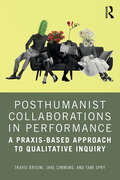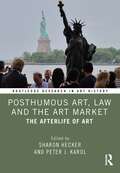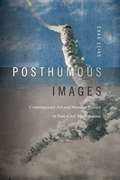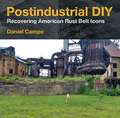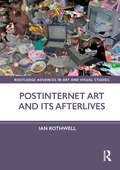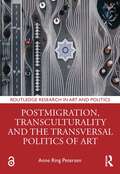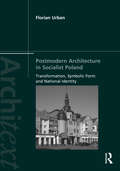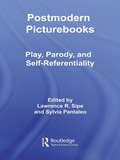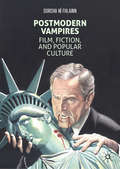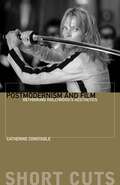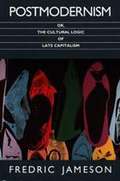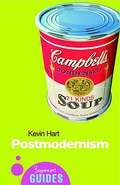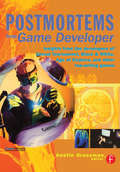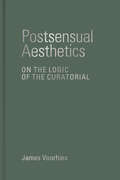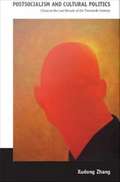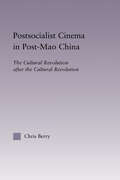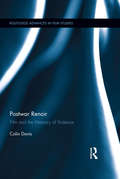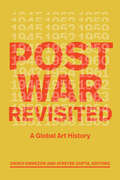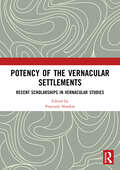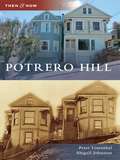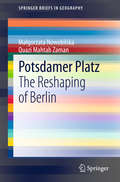- Table View
- List View
Posthumanist Collaborations in Performance: A Praxis-based Approach to Qualitative Inquiry
by Tami Spry Jake Simmons Travis BrisiniPosthumanist Collaborations in Performance presents a novel approach for readers to engage with new materialist performance as a method of qualitative inquiry and as a means of combating the anthropocentric loneliness of modern life.It offers a theoretical and practical examination of how we are fundamentally entangled with a more-than-human world through practices the authors call “naturecultural performances.” The book features a collaborative body of arts-based research by three scholars working at the intersections of performance studies, new materialism, environmental studies, and qualitative inquiry. The result is an interdisciplinary body of theoretical scholarship, including a wide array of landscapes, plants, animals, minerals, and other more-than-human agencies. The book also presents practical examples and case studies of naturecultural performances, showcasing the diverse ways in which the concept of “natureculture” can be applied in research and creative practice.This book will be of interest to faculty, graduate and undergraduate students, performance practitioners, and anyone else interested in exploring or creating work based on their own fundamental relationships with the more-than-human world.
Posthumous Art, Law and the Art Market: The Afterlife of Art (Routledge Research in Art History)
by Sharon HeckerThis book takes an interdisciplinary, transnational and cross-cultural approach to reflect on, critically examine and challenge the surprisingly robust practice of making art after death in an artist's name, through the lenses of scholars from the fields of art history, economics and law, as well as practicing artists. Works of art conceived as multiples, such as sculptures, etchings, prints, photographs and conceptual art, can be—and often are—remade from original models and plans long after the artist has passed. Recent sales have suggested a growing market embrace of posthumous works, contemporaneous with questioning on the part of art history. Legal norms seem unready for this surge in posthumous production and are beset by conflict across jurisdictions. Non-Western approaches to posthumous art, from Chinese emulations of non-living artists to Native American performances, take into account rituals of generational passage at odds with contemporary, market-driven approaches. The book will be of interest to scholars working in art history, the art market, art law, art management, museum studies and economics.
Posthumous Images: Contemporary Art and Memory Politics in Post–Civil War Lebanon (Art History Publication Initiative)
by Chad EliasFor almost two decades of its history (1975-90), Lebanon was besieged by sectarian fighting, foreign invasions, and complicated proxy wars. In Posthumous Images, Chad Elias analyzes a generation of contemporary artists who have sought, in different ways, to interrogate the contested memory of those years of civil strife and political upheaval. In their films, photography, architectural projects, and multimedia performances, these artists appropriate existing images to challenge divisive and violent political discourses. They also create new images that make visible individuals and communities that have been effectively silenced, rendered invisible, or denied political representation. As Elias demonstrates, these practices serve to productively unsettle the distinctions between past and present, the dead and the living, official history and popular memory. In Lebanon, the field of contemporary art is shown to be critical to remembering the past and reimagining the future in a nation haunted by a violent and unresolved war.
Postindustrial DIY: Recovering American Rust Belt Icons (Polis: Fordham Series in Urban Studies)
by Daniel CampoChronicles grassroots efforts to recover, rebuild, and enjoy architecturally iconic but economically obsolete places in the American Rust Belt.A pioneering Detroit automobile factory. A legendary iron mill at the edge of Pittsburgh. A campus of concrete grain elevators in Buffalo. Two monumental train stations, one in Buffalo, the other in Detroit. These once-noble sites have since fallen from their towering grace. As local elected leaders did everything they could to destroy what was left of these places, citizens saw beauty and utility in these industrial ruins and felt compelled to act. Postindustrial DIY tells their stories.The culmination of more than a dozen years of on-the-ground investigation, ethnography, and historical analysis, author and urbanist Daniel Campo immerses the reader in this postindustrial landscape, weaving the perspectives of dozens of DIY protagonists as well as architects, planners, and preservationists. Working without capital, expertise, and sometimes permission in a milieu dominated by powerful political and economic interests, these do-it-yourself actors are driven by passion and a sense of civic duty rather than by profit or political expediency. They have craftily remade these sites into collective preservation projects and democratic grounds for arts and culture, environmental engagement, regional celebrations, itinerant play, and in-the-moment constructions. Their projects are generating excitement about the prospect of Rust Belt life, even as they often remain invisible to the uninformed passerby and fall short of professional preservation or environmental reclamation standards.Demonstrating that there is no such thing as a site that is “too far gone” to save or reuse, Postindustrial DIY is rich with case studies that demonstrate how great architecture is not simply for the elites or the wealthy. The citizen preservationists and urbanists described in this book offer looser, more playful, and often more publicly satisfying alternatives to the development practices that have transformed iconic sites into expensive real estate or a clean slate for the next profitable endeavor. Transcending the disciplinary boundaries of architecture, historic preservation, city planning, and landscape architecture, Postindustrial DIY suggests new ways to engage, adapt, and preserve architecturally compelling sites and bottom-up strategies for Rust Belt revival.
Postinternet Art and Its Afterlives (Routledge Advances in Art and Visual Studies)
by Ian RothwellFocusing on the ‘postinternet’ art of the 2010s, this volume explores the widespread impact of recent internet culture on the formal and conceptual concerns of contemporary art. The ‘postinternet’ art movement is splintered and loosely defined, both in terms of its form and its politics, and has come under significant critique for this reason. This study will provide this definition, offering a much-needed critical context for this period of artistic activity that has had and is still having a major impact on contemporary culture. The book presents a picture of what the art and culture made within and against the constraints of the online experience look, sound, and feel like. It includes works by Petra Cortright, Jon Rafman, Jordan Wolfson, DIS, Amalia Ulman, and Thomas Ruff, and presents new analyses of case studies drawn from the online worlds of the 2010s, including vaporwave, anonymous image board culture, ‘irony bros’ and ‘edgelords’, viral extreme sports stunts, and GIFs. The book will be of interest to scholars working in art history, contemporary art, and digital culture.
Postmigration, Transculturality and the Transversal Politics of Art (Routledge Research in Art and Politics)
by Anne Ring PetersenThis is the first book to develop a postmigrant analytical perspective for the study of art, concentrating on how postmigration reopens the study of contemporary art and migration. The book introduces art historians and other scholars with a methodological interest in cultural analysis to the innovative concept of postmigration, offering a comprehensive introduction to the various meanings and uses of the term as well as translating it methodologically to an art historical context. The book analyses art projects from Denmark, Germany and Great Britain, which address some of the current challenges to European societies of immigration, and by drawing on theory from fields such as migration studies, transcultural studies and feminist, postcolonial and political theory, as well as re-engaging established concepts such as imagination, commemoration, belonging, identity, racialization, community, public space and participation. The book will be of interest to scholars working in art history, art and politics, migration studies, and transcultural studies.
Postmodern Architecture in Socialist Poland: Transformation, Symbolic Form and National Identity (Architext)
by Florian UrbanGarish churches, gabled panel blocks, neo-historical tenements—this book is about these and other architectural oddities that emerged in Poland between 1975 and 1989, a period characterised by the decline of the authoritarian socialist regime and waves of political protest. During that period, committed architects defied repressive politics and persistent shortages, and designed houses and churches which adapted eclectic historical forms and geometric volumes, and were based on traditional typologies. These buildings show a very different background of postmodernism, far removed from the debates over Robert Venturi, Philip Johnson, or Prince Charles in Western Europe and North America—a context in which postmodern architecture stood not for world-weary irony in an economically saturated society, but for individualised counter-propositions to a collectivist ideology, for a yearning for truth and spiritual values, and for a discourse on distinctiveness and national identity. Postmodern Architecture in Socialist Poland argues that this new architecture marked the beginning of socio-political transformation and at the same time showed postmodernism's reconciliatory potential. In light of massive historical ruptures and wartime destruction, these buildings successfully responded to the contradictory desires for historical continuity and acknowledgment of rupture and loss. Next to international ideas, the architects took up domestic traditions, such as the ideas of the Polish school of historic conservation and long-standing national-patriotic narratives. They thus contributed to the creation of a built environment and intellectual climate that have been influential to date. This book will be of great interest to students and scholars interested in postmodern architecture and urban design, as well as in the socio-cultural background and transformative potential of architecture under socialism.
Postmodern Picturebooks: Play, Parody, and Self-Referentiality (Routledge Research in Education)
by Sylvia Pantaleo Lawrence R. SipeOver the past 15 years, there has been a pronounced trend toward a particular type of picturebook that many would label "postmodern." Postmodern picturebooks have stretched our conventional notion of what constitutes a picturebook, as well as what it means to be an engaged reader of these texts. The international researchers and scholars included in this compelling collection of work critically examine and discuss postmodern picturebooks, and reflect upon their unique contributions to both the field of children’s literature and to the development of new literacies for child, adolescent, and adult readers.
Postmodern Vampires: Film, Fiction, and Popular Culture
by Sorcha Ní FhlainnPostmodern Vampires: Film, Fiction, and Popular Culture is the first major study to focus on American cultural history from the vampire’s point of view. Beginning in 1968, Ní Fhlainn argues that vampires move from the margins to the centre of popular culture as representatives of the anxieties and aspirations of their age. Mapping their literary and screen evolution on to the American Presidency, from Richard Nixon to Donald Trump, this essential critical study chronicles the vampire’s blood-ties to distinct socio-political movements and cultural decades in the late twentieth and early twenty-first centuries. Through case studies of key texts, including Interview with the Vampire, The Lost Boys, Blade, Twilight, Let Me In, True Blood and numerous adaptations of Dracula, this book reveals how vampires continue to be exemplary barometers of political and historical change in the American imagination. It is essential reading for scholars and students in Gothic and Horror Studies, Film Studies, and American Studies, and for anyone interested in the articulate undead.
Postmodernism and Film: Rethinking Hollywood's Aesthestics (Short Cuts)
by Catherine ConstableThis volume focuses on postmodern film aesthetics and contemporary challenges to the aesthetic paradigms dominating analyses of Hollywood cinema. It explores conceptions of the classical, modernist, post-classical/new Hollywood, and their construction as linear history of style in which postmodernism forms a debatable final act. This history is challenged by using Jean-François Lyotard's non-linear conception of postmodernism in order to view postmodern aesthetics as a paradigm that can occur across the history of Hollywood. This study also explores 'nihilistic' theorists of the postmodern, Jean Baudrillard and Frederic Jameson, and 'affirmative' theorists, notably Linda Hutcheon, charting the ways in which the latter provide the means to conceptualize nuanced and positive variants of postmodern aesthetics and deploying them in the analysis of Hollywood films, including Bombshell, Sherlock Junior, and Kill Bill.
Postmodernism and the Postsocialist Condition: Politicized Art under Late Socialism
by Ales ErjavecThis book, with in-depth perspectives on art and artists in the former Soviet Union, captures a singular period in the history of world art, and a critical moment in the cultural and political transition from the last century to our own.
Postmodernism, or, The Cultural Logic of Late Capitalism
by Fredric JamesonNow in paperback, Fredric Jameson's most wide-ranging work seeks to crystallize a definition of "postmodernism." Jameson's inquiry looks at the postmodern across a wide landscape, from "high" art to "low" from market ideology to architecture, from painting to "punk" film, from video art to literature.
Postmodernism: A Beginner's Guide (Beginner's Guides)
by Kevin HartKevin Hart introduces the reader to all of the major figures and issues in the field, including Derrida, Baudrillard and Foucault, as well as explaining what makes a thinker or writer postmodern.
Postmodernism: Architecture That Changed Our World
by Terry Farrell Adam Nathaniel FurmanFirst published in 2017 as Revisiting Postmodernism, this refreshed edition of a seminal text reflects on a design movement that changed our world. Postmodernism invites readers to explore the style in a new light, as the cultural phenomenon that it is, one which thrives on complexity and pluralism. Exploring its expression not only in architecture, but in design, urban planning and placemaking, Postmodernism reflects on the history of the movement and its continuing influence on design practice today.Sir Terry Farrell and Adam Nathaniel Furman present two separate but complementary perspectives of this rich period of architectural history; one account as lived experience from a protagonist and pioneer in the field of postmodern architecture, and the other analysing the movement afresh, through the lens of the 21st century.Shedding new light onto the forces and influences of the time, and offering insight into how these were transforming approaches to architecture both in the UK and internationally, this important book presents a new appreciation of this period of architectural history.Sumptuously illustrated with examples from across the globe, Postmodernism offers a fresh perspective on buildings of this period, sharing their richness, diversity, and brilliance, with an emphasis on what was interesting, beautiful and unique about the architecture which emerged from this unusually fertile moment in history.
Postmortems from Game Developer: Insights from the Developers of Unreal Tournament, Black & White, Age of Empire, and Other Top-Selling Games
by Austin GrossmanThe popular Postmortem column in Game Developer magazine features firsthand accounts of how some of the most important and successful games of recent years have been made. This book offers the opportunity to harvest this expertise with one volume. The editor has organized the articles by theme and added previously unpublished analysis to reveal successful management techniques. Readers learn how superstars of the game industry like Peter Molyneux and Warren Spector have dealt with the development challenges such as managing complexity, software and game design issues, schedule challenges, and changing staff needs.
Postsensual Aesthetics: On the Logic of the Curatorial
by James VoorhiesContemporary art exhibitions appeal to cognition as well as the senses, modeling a new and expansive understanding of global aesthetics.In this original work of aesthetic theory, James Voorhies argues that we live in the shadow of old ways of thinking about art that emphasize the immediate visual experience of an autonomous art object. But theory must change as artistic and curatorial production has changed. It should encompass the full range of activities through which we encounter art and exhibitions, in which reading and thinking are central to the aesthetic experience. Voorhies advances the theoretical framework of a &“postsensual aesthetics,&” which does not mean we are beyond a sensual engagement with objects, but rather embraces the cognitive connections with ideas that unite art and knowledge production. Cognitive engagements with art often begin with publications conceived as integral to exhibitions, conveying the knowledge and research artists and curators produce, and continuing in time and space beyond traditional curatorial frames. The idea, and not just visual immediacy, is now art&’s defining moment. Voorhies reframes aesthetic criteria to account for the liminal, cognitive spaces inside and outside of the exhibition. Surveying a wide range of artists, curators, exhibitions, and related publications, he repositions the aesthetic theory of Theodor Adorno, and draws inspiration from Rosalind Krauss and Fredric Jameson, to describe a contemporary &“logic of the curatorial.&” He demonstrates how, even as we increasingly expect to learn from contemporary art, we must avoid an instrumentalist and reductive view of art as a mere source of information. As Voorhies shows through an analysis of two major global exhibitions, dOCUMENTA (13) (artistic director Carolyn Christov-Bakargiev) and Documenta11 (artistic director Okwui Enwezor), and of Ute Meta Bauer&’s curatorial work at the Centre for Contemporary Art Singapore, it is imperative for artistic research to retain its unique role in the production of knowledge.
Postsocialism and Cultural Politics: China in the Last Decade of the Twentieth Century
by Xudong ZhangIn Postsocialism and Cultural Politics, Xudong Zhang offers a critical analysis of China's "long 1990s," the tumultuous years between the 1989 Tiananmen Square crackdown and China's entry into the World Trade Organization in 2001. The 1990s were marked by Deng Xiaoping's market-oriented reforms, the Taiwan missile crisis, the Asian financial crisis, and the end of British colonial rule of Hong Kong. Considering developments including the state's cultivation of a market economy, the aggressive neoliberalism that accompanied that effort, the rise of a middle class and a consumer culture, and China's entry into the world economy, Zhang argues that Chinese socialism is not over. Rather it survives as postsocialism, which is articulated through the discourses of postmodernism and nationalism and through the co-existence of multiple modes of production and socio-cultural norms. Highlighting China's uniqueness, as well as the implications of its recent experiences for the wider world, Zhang suggests that Chinese postsocialism illuminates previously obscure aspects of the global shift from modernity to postmodernity. Zhang examines the reactions of intellectuals, authors, and filmmakers to the cultural and political conflicts in China during the 1990s. He offers a nuanced assessment of the changing divisions and allegiances within the intellectual landscape, and he analyzes the postsocialist realism of the era through readings of Mo Yan's fiction and the films of Zhang Yimou. With Postsocialism and Cultural Politics, Zhang applies the same keen insight to China's long 1990s that he brought to bear on the 1980s in Chinese Modernism in the Era of Reforms.
Postsocialist Cinema in Post-Mao China: The Cultural Revolution after the Cultural Revolution (East Asia: History, Politics, Sociology and Culture)
by Chris BerryThis book argues that the fundamental shift in Chinese Cinema away from Socialism and towards Post-Socialism can be located earlier than the emergence of the "Fifth Generation" in the mid-eighties when it is usually assumed to have occured. By close analysis of films from the 1949-1976 Maoist era in comparison with 1976-81 films representing the Cultural Revolution, it demonstrates that the latter already breaks away from Socialism.
Postwall German Cinema
by Mattias FreySince the fall of the Berlin Wall, there has been a proliferation of German historical films. These productions have earned prestigious awards and succeeded at box offices both at home and abroad, where they count among the most popular German films of all time. Recently, however, the country's cinematic take on history has seen a significant new development: the radical style, content, and politics of the New German Cinema. With in-depth analyses of the major trends and films, this book represents a comprehensive assessment of the historical film in today's Germany. Challenging previous paradigms, it takes account of a postwall cinema that complexly engages with various historiographical forms and, above all, with film history itself.
Postwar Renoir: Film and the Memory of Violence (Routledge Advances in Film Studies)
by Colin DavisThis book re-assesses director Jean Renoir’s work between his departure from France in 1940 and his death in 1979, and contributes to the debate over how the medium of film registers the impact of trauma. The 1930s ended in catastrophe for both for Renoir and for France: La Règle du jeu was a critical and commercial disaster on its release in July 1939 and in 1940 France was occupied by Germany. Even so, Renoir continued to innovate and experiment with his post-war work, yet the thirteen films he made between 1941 and 1969, constituting nearly half of his work in sound cinema, have been sorely neglected in the study of his work. With detailed readings of the these films and four novels produced by Renoir in his last four decades, Davis explores the direct and indirect ways in which film, and Renoir’s films in particular, depict the aftermath of violence.
Postwar Revisited: A Global Art History
by Okwui Enwezor Atreyee GuptaOkwui Enwezor’s 2016 exhibition Postwar: Art between the Pacific and the Atlantic, 1945–1965 redefined the history of art produced in those two decades. Nearly a decade later, Postwar Revisited returns to these debates to present an image of a historical period in which Western conceptions of art, aesthetics, and philosophy are all thrown into intense flux after Auschwitz and Hiroshima, while the cultural energies of decolonization generate myriad artistic and intellectual practices across the globe, which re-engage the connections of art to life itself. Focusing on modernist artists, artist collectives, and architects central to dissonant regional traditions, as well as influential exhibitions and patronage systems, the contributors produce a new understanding of emergent postwar global art. Provoking new ways of thinking, engaging, and narrating art history, Postwar Revisited is essential reading for those interested in debates on global art history and global modernism, the intersections between art and decolonization, the cultural aspects of the Cold War and the Non-Aligned Movement, and modern and contemporary art more generally.Contributors. Iftikhar Dadi, Okwui Enwezor, Patrick Flores, Hal Foster, Boris Groys, Atreyee Gupta, Elizabeth Harney, Jennifer Josten, Vivian Li, Tara McDowell, Alexandra Munroe, Nada Shabout, Terry Smith, Jenni Sorkin, Ming Tiampo
Potency of the Vernacular Settlements: Recent Scholarships in Vernacular Studies
by Pratyush ShankarThe 11th ISVS (International Seminar for Vernacular Settlements) that was hosted by the School of Environmental Design and Architecture, Navrachana University brought together some important ideas and concerns as related to questions of development at large and vernacular settlements. From questions of ecological balance, use of resources and the way of the pastoral to the ones concerning technology, design and materiality of built environment. The 11th ISVS will be remembered as one that brought whole generation of young and talented scholars in the foreground. Many of them had carried out extensive field work to support their research. The seminar was also remarkable from the point of view of extensive representation of vernacular traditions in different part of the Indian Sub-continent and Southeast Asia along with a range of theoretical concerns.
Potrero Hill
by Peter Linenthal Abigail JohnstonA neighborhood in the southeast corner of San Francisco, Potrero Hill enjoys some of the city's finest weather and most spectacular views. Once pastureland and home to immigrants working in the shipbuilding industries, Potrero Hill was long ignored by guidebooks. Now "The Hill" is regenerating, and these pages highlight what is gone and what remains on these sunny slopes.
Potsdamer Platz
by Malgorzata Nowobilska Quazi Mahtab ZamanThe redesign of Potsdamer Platz depicts the struggle to revive Berlin, Germany. This central and highly visible square has undergone a series of strategic revisions to restore its vitality and so to meet place-enhancing objectives. Specifically, the book critically addresses the challenging tasks of restoring Potsdamer Platz from a state of disintegration to a condition worthy of a world-class city, although the questions remain unanswered as to how far the objectives have been achieved. The book enables readers to become familiar with the various stages of transformation, aided by the authors' hand-drawn illustration - a series of sketches accompanied by narrations focusing on how to critically read 'cities in transformation'. As a whole, it presents an overview of the strategic process of urban regeneration. The findings from this theoretical exploration help reposition our understanding of the process of re-making a 'city in decay and transition'; and introduces new strands of regeneration ideologies, politics and methods.
Potted: Make Your Own Stylish Garden Containers
by Annette Goliti Gutierrez Mary GrayHand-made style for outdoor living Outdoor style often comes at a high price, but it doesn’t have to. This lushly designed guide empowers you to create your own show-stopping containers made from everyday materials such as concrete, plastic, metal, terracotta, rope, driftwood, and fabric. The 23 step-by-step projects are affordable, made from accessible materials, and most importantly, gorgeous. They include new spins on old favorites, like the cinderblock garden made popular by design blogs or hanging planters made from enamelware bowls, along with never-before-seen ideas like a chimney flue planter and wall planters made from paint cans. Packed with color photographs and simple instruction, Potted is for anyone who wants to turn an outdoor space into a stylish oasis.
